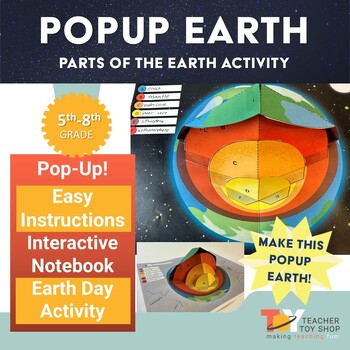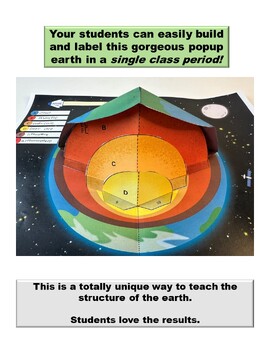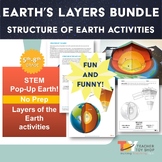Layers of the Earth and Earth Day STEAM Paper Model Activity for Earth Science
- PDF
- Google Apps™

Also included in
- Teach the earth's layers and structure of earth with this bundle. These activities are lots of fun and your students will remember the parts of the earth and understand the science behind the spheres of the earth, when they've completed them. Ideal for middle school science or high school earth sciePrice $6.50Original Price $8.25Save $1.75
- Access a comprehensive array of Earth Science resources with Earth Science Activities and Lesson Plans Bundle, curated by Teacher Toy Shop! This all-inclusive bundle provides educators with a wealth of engaging materials to enrich their Earth Science curriculum. From science worksheets to hands-on sPrice $16.00Original Price $23.49Save $7.49
Description
Learn about Earth's Layers and the structure of the Earth with this STEM Pop-Up Card Activity! Students will build a model to illustrate the compositional and mechanical layers of Earth, including the crust, mantle, outer core, inner core, asthenosphere, and lithosphere.
This hands-on project offers an engaging way to explore the spheres of the Earth while reinforcing concepts in earth science. Students construct and label their own 3D Earth, a kinesthetic hands-on activity which helps students to remember the parts of Earth. Whether incorporated into interactive science notebooks or sent home as an educational Earth Day card, this activity provides a memorable learning experience on Earth's structure. It can be completed in just one class period.
Included are printable files for creating the 3D Earth, along with simple step-by-step instructions and a helpful video tutorial. Students will learn to identify and label essential parts of the earth, including the crust, mantle, outer core, inner core, lithosphere, asthenosphere, and more. Also includes a bonus activity to connect and label constellations!
Versatile as an earth craft, this activity can be integrated into various educational lessons, from earth science units to STEM or STEAM crafts, and Earth Day activities.
Whether used in traditional classrooms or adapted for distance learning or homeschoolers, this Earth's structure resource is perfect for educators and students.
Spark curiosity and fun exploration in your classroom with Layers of the Earth and Earth Day STEAM Paper Model Activity for Earth Science.
► What's Included?
- 3D Earth's Layers Printable Files
- Simple instructions (both printable and Google Slides™ versions) for making the Earth's structure craft PLUS a link to watch a video showing how to make it
- Instructions for labeling the parts of the Earth: crust, mantle, outer core, inner core, lithosphere, asthenosphere
- Bonus activity to connect and label constellations: the Big Dipper, Orion, Leo, Scorpio, and Cassiopeia
- Parts of the Earth Diagram
- Version without labeling which can be used as an Earth Day card or an all-occasion card
- Low-color and B&W versions to reduce printer ink or to have students color their own layers of the earth
- Multiple card front designs
- Answer Key
You Might Also Like...
- Volcanoes Natural Disasters Earth Science Activity - STEM Pop-Up Card
- Layers of the Earth Informational Text and Reading Comprehension Earth Science
- Parts of a Flower STEAM Activity
- Mineral Identification Lab | Rocks and Minerals Activity
⚠️ BUNDLE & SAVE! ⚠️ Get ALL of Teacher Toy Shop's Earth Science Resources and SAVE with this Earth Science Bundle!
✪ Don't forget to follow Teacher Toy Shop to be the first to know about new products, sales and freebies!







